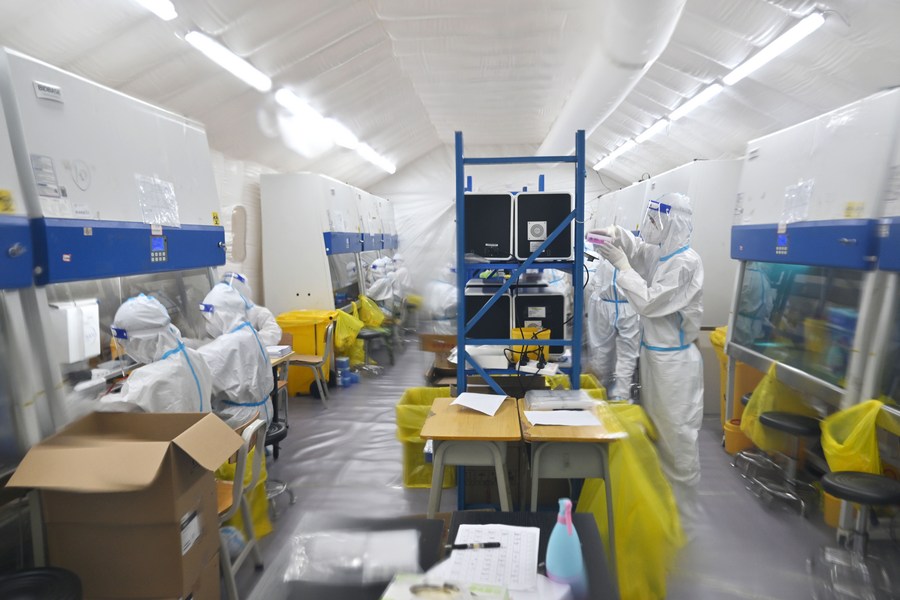Institutional strengths emerge in China's fight against COVID-19, economic slowdown
 0 Comment(s)
0 Comment(s) Print
Print E-mail Xinhua, September 27, 2022
E-mail Xinhua, September 27, 2022

More than two years into the COVID-19 epidemic, China has achieved the best results among major countries in coordinating epidemic control and keeping the economy steady and sound.
China was the only major country whose economy grew in 2020. This year, braving a series of challenges posed by the Omicron outbreak and a worsening global environment, China posted a 2.5 percent year-on-year growth in the first half and is on track for further recovery.
Meanwhile, the incidence rate and the death toll of COVID-19 in China have been the lowest among major countries.
Creating synergy
The key to China's leading performance in both economic development and COVID-19 containment lies in the institutional strengths of the leadership of the Communist Party of China (CPC) and the country's socialist system.
After the outbreak of COVID-19, China mobilized the public to engage in epidemic prevention, allocated resources with high efficiency across the country, and secured much-needed logistics support.
Medical workers rose to the challenge. For instance, more than 10,000 medical workers from 19 provincial-level regions rushed to Hainan Province this summer to aid the island's fight against the virus. Thanks to joint efforts, the number of new infections in Hainan has declined since September.
In addition, more than 4 million community workers have worked in 650,000 urban and rural communities across the country since the onset of the epidemic. Millions of ordinary people have volunteered their services, including cleaning and disinfecting public spaces, buying medicines, and delivering groceries.
By mobilizing the people extensively, China has built a strong line of defense against the virus.
Late at night on Aug. 25, six sets of nucleic acid sampling workstations arrived in Kashgar, Xinjiang Uygur Autonomous Region, from east China's Shandong Province. They were immediately put into use in key areas.
During the recent COVID-19 outbreak in Xinjiang, many provinces and cities that have pair-up assistance programs with the region have rushed emergency supplies as the country has long been upholding the traditional values of "helping each other" and "helping those in need."
People-centered philosophy
On April 30, a 106-year-old patient surnamed Li was cured of COVID-19 and discharged from the hospital after treatment. She was the oldest COVID-19 patient admitted to the hospital in northeast China's Jilin Province.
From newborns to centenarians, people's lives and health have been protected with every possible effort. It was an unswerving choice of China in the face of the epidemic.
Over the past two years, China has constantly adjusted its COVID-19 responses to new situations. Makeshift hospitals were built fast, treatment costs were fully covered by the government, and food supply and prices were stabilized.
About 61.8 billion yuan (about 8.8 billion U.S. dollars) from the central government budget has been allocated to support employment and pay endowment insurance for over 16 million urban and rural residents this year.
While balancing COVID-19 control and economic growth, China has sought to boost people's sense of gain in the long run.
Official data showed that the average life expectancy in the country rose to 78.2 years in 2021, with over 1.36 billion people covered by the basic medical insurance system.
Its per capita share of grain, which reached 483 kg last year and remained well above the internationally recognized security line of 400 kg, has provided a solid underpinning for the grain security of the world's most populous country.
On the environmental front, it is now the fastest country globally in tackling air pollution, with the number of days with heavy pollution significantly reduced in recent years.
The Chinese economy has achieved positive growth in the second quarter, with its major economic indicators firming up across the board since June, demonstrating the resilience of the world's second-largest economy.
In times full of uncertainties and volatilities, the institutional strengths of the leadership of the CPC and the socialist system remain a fundamental and powerful guarantee in steering the country's development.
China must contain the epidemic, stabilize the economy, and keep development secure, according to a meeting of the Political Bureau of the CPC Central Committee in April.





